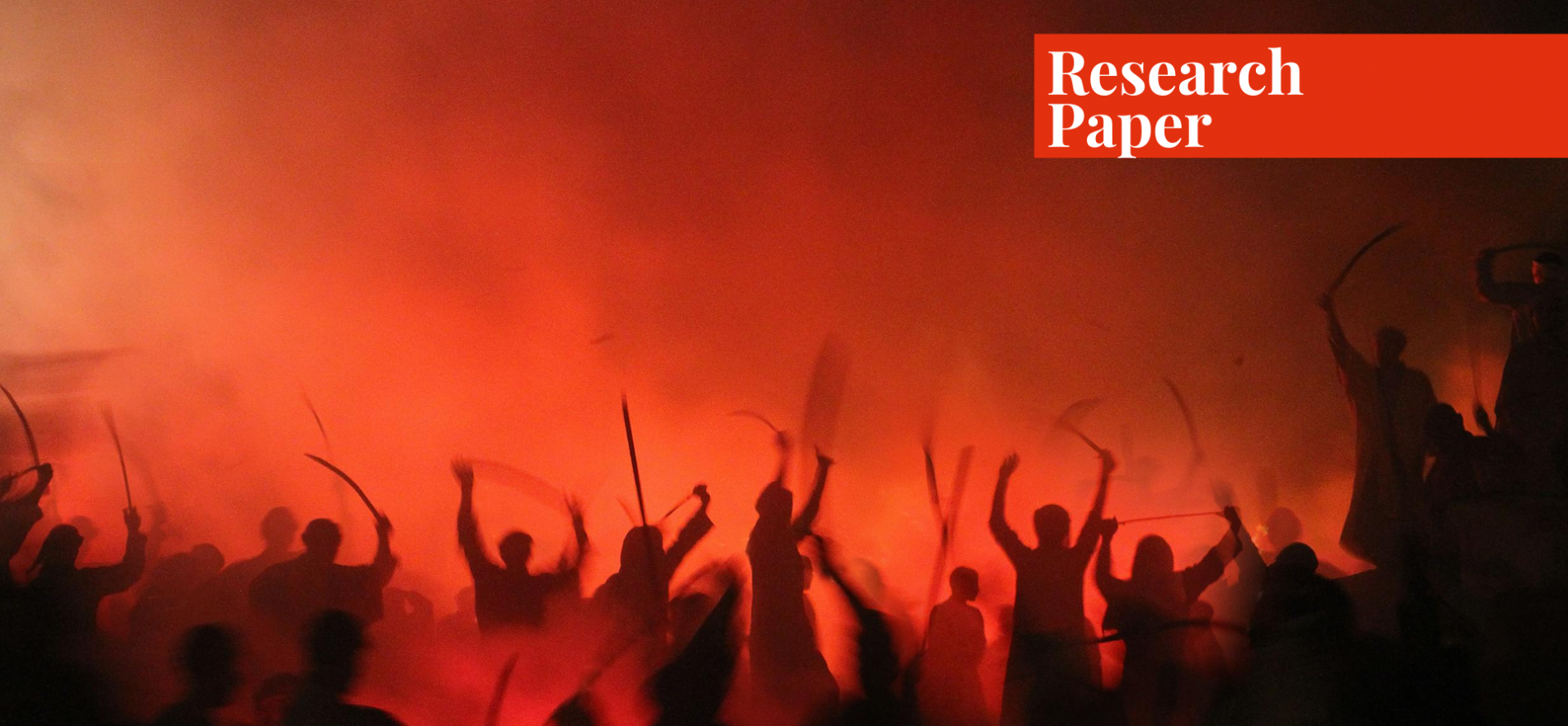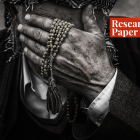Kinza shah is a public policy lecturer at National Defense University, Islamabad. She has done her Bachelors in Public Administration from NUST, Islamabad. Later on she went to study governance and public policy at the National Defense University, Islamabad. Her research interests include democratic governance, citizen participation, youth policy, and career counselling. She tweets at @kenzashah
Written in 2013
Introduction
In essence, sectarianism can range from merely displaying bigotry or hatred towards people belonging to other sects, to vicious and deliberate eradication of people having opposing ideologies. Undoubtedly, one state, in particular, is in the eye of the proverbial storm – the storm being the whirlwind of increasing sectarianism in Pakistan.
One of the definitions of “sectarian” is a person who is either narrow-minded or bigoted. This definition feeds the term “sectarian violence”, which may be delineated in many ways. Some define sectarian violence as forcing others to adopt one’s ideology, while others describe it as the employment of disturbing, potentially lethal, methods, and techniques for eradicating anyone who has a different school of thought/ideology.
Coming now to “indoctrination” – indoctrination is defined as an intentional method of teaching for either incorporating certain ideologies or aggravating an already established one.
Thousands of lives have been lost in Pakistan in the name of sectarianism. Even more ironic is the fact, that both the killer and the victim are branded “shaheed” (immortal) by their respective sects. This consideration alone is sufficient to highlight the great religious divide present in the country – either created & perpetrated at the individual level, or by the state at the macro-level (Nasr, 2006).
Predominantly, a society having weak educational infrastructure is certainly more vulnerable to indoctrination. Pakistan has a myriad of different sects, with largely different (and sometimes extreme) religious practices. In addition, it is a country with a weak educational infrastructure due to one reason or the other. It is pertinent to state that Pakistan has become a classic example of both sectarianism and indoctrination. Before delving into how indoctrination fuels sectarianism, one needs to understand why indoctrination is being used to achieve religious objectives in Pakistan.
Background of Sectarianism in Pakistan
The origins of the prevalent circumstances can be traced back to 1977 when the dictator Zia ul Haq had to legitimize his bloodless coup of the previous government and also to accumulate public support. In broader terms, he raised the slogan of Islamic universalism, employing Islam as a tool to acquire political standing. He realized that rallying the already “emotional” nation around a religious cause would bode well for him. To achieve his cause, he gathered all the religious zealots, who were otherwise dormant in the society at that time. To create a so-called sense of religious harmony in Pakistan, he favored the Sunni Islamic sect over the Shia one. This ironically affected the country in the converse as it led to the propagation of a religious divide.
The seeds of dissension grew largely during the Afghan war in 1979. Islamic universalism was once again nurtured – this time through the dollars supplied by America. The U.S. had just one interest: to counter the Soviets in Afghanistan. They wanted a front-line “ally”, and Zia ul Haq rendered his “meritorious” services for the cause. American funding was employed in madrasas (religious seminaries), where kernels of hatred for other religious identities started growing. Moreover, Pakistan’s old ally Saudi Arabia also played a pivotal role during this time. And as the story goes, Saudi Riyals and American dollars raised a unique and detrimental religious mindset in both Pakistan and Afghanistan.
Growing in parallel to the formation of a stringent religious ideology in Pakistan was the revolution in the country’s neighbor, Iran. The Iranian Revolution (based on Shi’ism) was perceived to be an indirect threat to the contrary mainstream Sunnireligious mindset in Pakistan, which was being supervised by Zia. Saudi Arabia fueled anti-Iranian sentiment in Sunni madrasas while Iran fueled anti-Saudi sentiment in Shia-funded madrasas across Pakistan. All these factors affected the religious environment of Iran and Pakistan cumulatively. The Sunni militant wings raised under the auspices of Zia were detailed to target Iranian emissaries and pro-Iran people in Pakistan. The proxy war between Saudi Arabia and Iran came into play and Pakistan became the playground.
Raised in the 1980s, religious zealots multiplied their strength by force – and at times by according monetary benefits. In 1988, the number of unregistered madrasas in Pakistan were around 25,000 (Rashid, 2000).
Weak democratic governments in the 1990s also helped religious fundamentalists to expand unchecked and gain strength with time. Weak governance by the two dominant political parties during the 90s essentially led to the strengthening of fundamentalists in acquiring a political foothold. In the mid-1980s, the Sunni (Deobandi) sectarian militant group Sipah-e-Sahaba Pakistan (SSP) rose to prominence. They carried out attacks against Shia Muslims around Pakistan and as a direct consequence, it led to the creation of the Shia militant group Sipah-e-Muhammad Pakistan (SMP). The SMP conducted slayings of anti-Shia leaders and battled against the SSP. Both groups have “waged a brutal and bloody campaign to safeguard the interest of their respective communities.” (Nasr, 2000). Strengthened both in power and numbers, the religious sects proliferated madrasas all across Pakistan. The noble cause of imparting religious studies in madrasas was substituted with disseminating hatred towards opposing ideologies – this led to the birth of radical madrasas. This was further exacerbated because of the country’s weak educational infrastructure which led to the poverty-ridden masses being used by fundamentalists on both sides.
Only recently have these radicals begun to face resistance from the masses, the media, the judiciary, and the military. Fearful of their survival, these fundamentalists are voluntarily being enacted by regional and global powers and all other forces that oppose the creation of a stable Pakistan. Since their existence is at stake, the fundamentalists devise means to counter the threat. Indoctrination is one of the tools these bigots have resorted to for the continuation of their existence.
Indoctrination in Pakistan
Indoctrination is a method of inculcating one’s own ideology in others – indoctrination corrupts the mind of the common person. There are several types of indoctrination and while some pertain to social justice, others pertain to different ideologies relating to religion, ethnicity, and anti-state sentiments. The extreme “Islamist mullahs” who are predominantly engaged in the indoctrination of people do not amount to a significant number as they make up only 11% to 15% of the total population (Oldenburg, 2009). Since directly confronting the state and state-run institutions is not a viable option, they resort to activities that are productive yet feasible. Indoctrination may be time-consuming, but it is a ruthless way of instilling one’s own ideas in another’s mind.
Vis-à-vis religious indoctrination, it is pertinent to state that radical madrasas in Pakistan are the primary source of proselytizing sectarianism. It is a sorry state of affairs that being an Islamic republic, Pakistan does not possess a single central Islamic authority that has the powers to award degrees to religious scholars and give them the “official approval” to preach. Since Pakistan is divided amongst sects, every religious sect has its own scholarly institute. These institutes recognize only those religious scholars who follow the same ideology as the institute. Since certain segments of the population are dichotomized by their respective sects, there is a lack of religious unity in society. It is ironic that some Pakistanis display hatred to Muslims from other sects, but take refuge in non-Muslim funding – solely to achieve the goal of eradicating their brethren Muslims.
Methods may vary, but the end is the same i.e. to spread intolerance and in some cases, prepare people for acts of terrorism. The phenomenon of religious indoctrination is not sect-specific as various Sunni and Shia madrassas alike partake in the employment of this sinister methodology. To begin with, it is important to understand why people join the madrasas. There are certain factors cited by various scholars as to why children are sent to madrasas. First, the poverty-stricken masses cannot find educational institutes for their children without incurring a cost. Madrasas are the only “educational” bodies that are willing to take care of the children’s education, clothing, and food simultaneously for free.
Secondly, since madrasas are religious seminaries, parents consider it a religious duty to send their children to them – and therefore do not bother verifying the authenticity of the curriculum.
Thirdly, followers of any religious personality/leader – primarily in the rural areas – undeniably send their children to the religious seminaries founded by the same personality. With the given information, one can easily conclude that the children who are inducted into the madrasas are besieged by either poverty of their families, lack of resources, flawed religious logic, pressure from the elders, or lack of options. Hence, by any means, the children submit to the teachings, no matter how radical they may seem. The students of the seminaries know that they cannot revert to their families, and hence their bread and butter lies in whatever the madrasas’ authorities give them.
However, the paper must highlight here that some studies suggest a narrative contrary to the mainstream beliefs regarding madrasas. Andrabi et al. (2008), for example, found that madrasas account for less than 1% of total enrolment in Pakistan.
Fear is the biggest weapon that is used to indoctrinate the students in madrasas. Imagine a child of 10 years or less, who did not even get to eat his fill while at home. He understands that he is forcibly in the madrasa – either because of the financial constraints or because of ideological stances. The child has no way back, and more oft than not, he is beaten, whipped or chained into submission (instances of which have been highlighted in the media various times). Keeping all this in mind, it is justifiable to say that domestic circumstances push children & their families to a point where the children start accepting whatever is taught to them.
Chandran (2003) has quite rightly pointed out that one of the primary causes of sectarian violence in Pakistan is the madrasa system, where various religious fundamentalists start polluting young minds from an early age. Indoctrination in radical madrasas is a slow but effective process, where the youth can be trained for any kind of extreme act – from assassination to suicide bombing. It would be justified to say that the nurturing of young minds that have been beleaguered by their domestic circumstances, is done along the lines of religious hatred/sectarianism by religious diehards in many madrasas of Pakistan. Here, indoctrination is employed for proving their own righteousness, and for instilling hatred towards other schisms (Chandran, 2003).
Another illustration of indoctrination is in the creation of suicide bombers. Suicide bombers are have been used against state-run institutes, but noteworthy is the fact that suicide bombing acquired its initial roots under the shadows of sectarianism. The perpetrators of this unethical and heinous act may use it as per their wish and will, but religious extremists use it as a primary tool for killing people of opposing sects. Vis-à-vis suicide bombing Lakhani (2010) states that “In radical madrasas, the reframing of both jihad and martyrdom are instrumental in glorifying the acts of suicide bombers. These themes also further reinforce the fundamental narrative – that Islam is under threat, and suicide bombing is a tool ‘to teach the enemy a lesson,’ a phrase often used by radical clerics and teachers and subsequently parroted by impressionable madrasa students.”
After these lectures, the naïve children are told of the heavenly rewards which await them just after they culminate their tasks (which normally is the eradication of non-believers or people belonging to opposing schisms). From the perspective of radical madrasas, children are seen as “expendable human resources” (Lakhani, 2010). Luring them into fantasies of the rewards of the after-life, their teachers/handlers redirect them to the employment of suicide jackets. The use of the jacket is taught comprehensively. On the last day of their training, the suicide bombers are taken to a painted hall showing lush green fields and gushing springs. Therefore, just before the actual assault, the bombers are refreshed with the image of heaven. Then comes the final moment when they blast themselves in a mosque or a religious procession – or any other place or event not related to their masters’ sect. Where the aftermath of such tragic incidents yield agony, grief, and sorrow amongst the bereaved families, it also instills anger and rage amongst them due to the loss of their loved ones in a horrific fashion. Revenge boils their blood. And at times they reciprocate in the same manner against the rival sect, resulting in an environment saturated with sectarian violence. The seeds of indoctrination by extremists (who are funded by non-state actors or foreign powers) yield sectarian violence. Widespread hatred and revenge are just additional by-products.
Recommendations
Curbing sectarianism (and indoctrination) requires certain major steps. First and foremost is the need for resilient governance by the government. The stronger the governance, the lesser the sectarian violence. When the ruling party is strong, they do not make compromises or concede to fanatics for political gains. Second, and perhaps the most important is education. Chandran (2003) states in his article that Pakistan has a literacy rate lower than 40% (lowest in South Asia). Education enlightens the mind and also creates opportunities.
Many (not all) of the Pakistanis involved in suicide bombings and religious extremism have been relatively less educated or not educated at all. Chandran is right to assert that unless the state increases its role in education and completely reforms the madrasa system, the systematic indoctrination of sectarian hatred will continue unabated. Strengthening the state-run educational systems, introducing a uniform educational system, preventing the wrongful utilization of external funds by madrasas (and even regulating and auditing the foreign state funding of madrasas), would go a long way in ensuring that the teachers disseminate the correct teachings of the Quran – and ultimately reduce sectarianism in Pakistan. Furthermore, radical madrasas that cease to give up teaching extremism must be closed and their administration must be tried against and jailed. Lastly, as mentioned above, the foreign funding of madrasas should be monitored. Inter-state diplomacy should be used to eliminate the funding of extremist madrasas.
Conclusion
Pakistan was created in the name of Islam where people could have religious freedom in spite of their different faiths or sects. Since Zia’s Islamization drive things began worsening and they further deteriorated after 9/11.
While many argue that the funders of religious extremism are foreigners (Americans, Indians, Israelis, Saudis, and Iranians etcetera), the fact of the matter is that those who execute the crimes are fundamentalist Pakistanis. The thin religious divide and the frail domestic circumstances are used by Pakistan’s adversaries to fulfill their ulterior motives. The need of the hour is to strengthen the roots of the country’s educational system and madrasas to ensure quality education, both religious and otherwise, is available to all. To make this idea a reality, Pakistan needs the government to step up and play an enhanced role. Sectarianism has plagued society for decades and therefore Pakistan needs to address the disease, not the patient.
Bibliography
- Andrabi, T., Das, J., Khwaja, A. I., & Zajonc, T. (2008). Madrassa Metrics: The Statistics and Rhetoric of Religious Enrollment in Pakistan. Harvard Kennedy School. https://epod.cid.harvard.edu/sites/default/files/2018-02/madrassa_metrics-_the_statistics_and_rhetoric_of_religious_enrollment_in_pakistan.pdf
- Chandran, S. (2003). Sectarian Violence in Pakistan. Institute of Peace and Conflict Studies. http://www.ipcs.org/issue_briefs/issue_brief_pdf/1614934887IB09-SubaChandran-SectarianViolencePak.pdf
- Lakhani, K. (2010). Indoctrinating Children: The Making of Pakistan’s Suicide Bombers. CTC Sentinel, 3(6), 11-13. https://www.ctc.usma.edu/wp-content/uploads/2010/08/CTCSentinel-Vol3Iss6-art4.pdf
- Nasr, V. R. (2006). The Shia Revival, How Conflicts within Islam Will Shape the Future. W.W. Norton & Company.
- Nasr, V. N. (2000). International Politics, Domestic Imperatives, and Identity Mobilization: Sectarianism in Pakistan, 1979-1998. Comparative Politics, 32(2), 171-190. https://www.jstor.org/stable/422396
- Oldenburg, P. (2009) Different Faiths, Divided States. India International Centre Quarterly, 35 (3/4), 58-71. https://www.jstor.org/stable/23006248
- Rashid, A. (2000). Taliban: Militant Islam, Oil and Fundamentalism in Central Asia. Yale University Press
If you want to submit your articles and/or research papers, please check the Submissions page.















